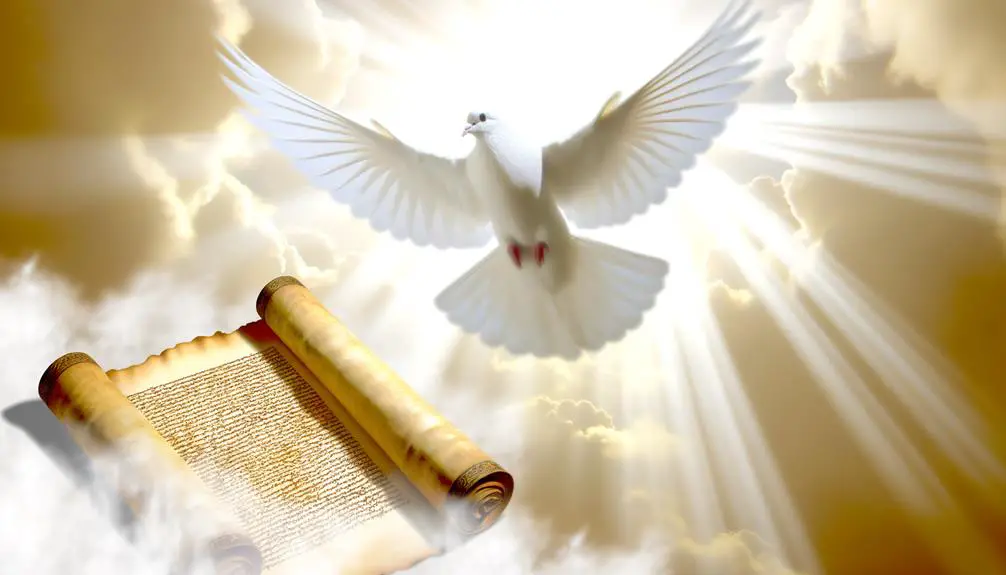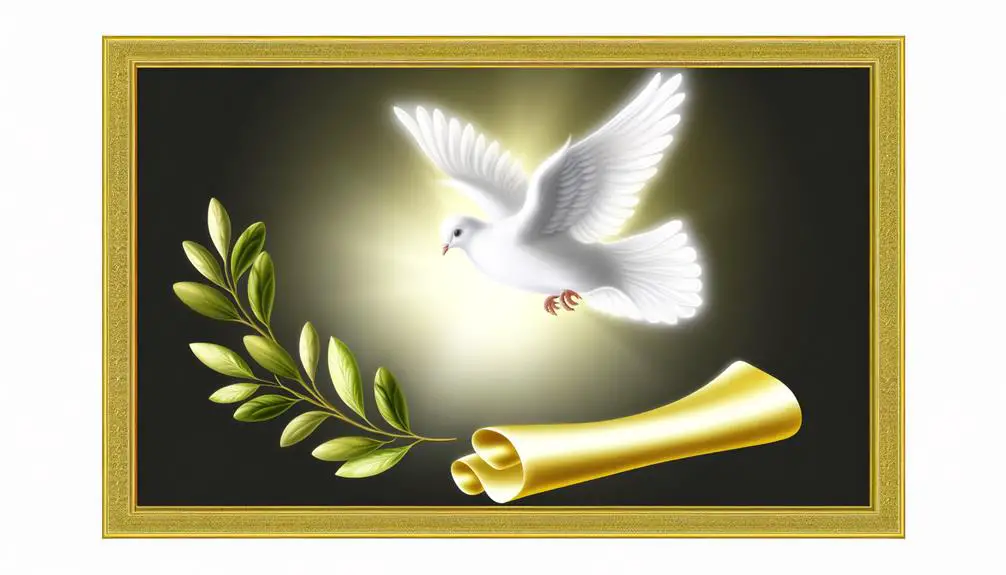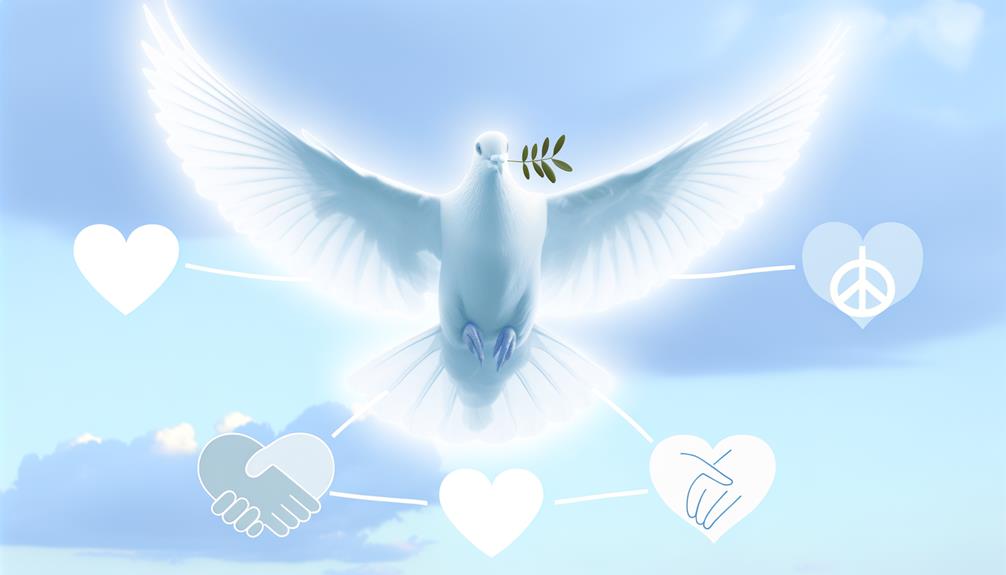How to Interpret the Dove Symbol: A Guide to Its Meaning
The dove has rich symbolism in various cultures, often embodying peace, love, and purity. In Ancient Greece, it was linked to Aphrodite, the goddess of love, while in Mesopotamian culture, it represented Inanna-Ishtar, the fertility goddess.
Religious texts across Christianity, Judaism, and Islam regard the dove as a sign of divine purity and spiritual serenity. It signifies peace in the story of Noah's Ark and is a symbol for the Holy Spirit in Christianity.
Contemporary interpretations extend its meaning to peace activism, environmental balance, and global unity. To explore these multifaceted symbolisms further, there is much more to uncover.

Key Takeaways
- The dove symbolizes peace, love, and purity across various ancient cultures and religions.
- In Christianity, the dove represents the Holy Spirit and divine peace.
- The dove is an enduring emblem of global harmony and hope in modern peace movements.
- In literature and art, the dove evokes themes of love, fidelity, and spiritual purity.
- Contemporary interpretations of the dove include environmental consciousness and global unity.
Dove in Ancient Cultures

Throughout ancient cultures, the dove has consistently been a profound symbol of peace, love, and purity, often intertwined with religious and mythological narratives.
In Ancient Greece, the dove was sacred to Aphrodite, the goddess of love, symbolizing affection and fidelity. Similarly, in Mesopotamian culture, doves were associated with Inanna-Ishtar, the goddess of fertility and sexual love, epitomizing life's regenerative forces.
Ancient Egyptians revered the dove as a symbol of innocence and a harbinger of tranquility. Additionally, in Roman culture, doves were linked to Venus, reinforcing themes of romantic harmony.
These symbolic associations underscore the dove's universal resonance across diverse civilizations, reflecting humanity's enduring quest for harmony, spiritual purity, and the sanctity of love.
Dove in Religious Texts

The symbolic significance of the dove extends seamlessly into religious texts. In various faiths, it is often depicted as a messenger of divine peace and spiritual purity. Prominently featured in the narratives of Christianity, Judaism, Islam, and Hinduism, the dove embodies profound theological concepts and sacred themes.
Christianity:
The dove represents the Holy Spirit, as seen during Jesus' baptism when the Spirit descended 'like a dove' (Matthew 3:16).
Judaism:
In Genesis, a dove returned to Noah with an olive branch, signifying the end of the flood and God's reconciliation with humanity (Genesis 8:11).
Islam:
Though not as central, the dove is respected for its association with purity and peace.
Hinduism:
The dove symbolizes the soul's eternal journey and spiritual liberation.
These depictions underscore the dove's role in conveying divine messages and sanctity.
Dove as a Peace Symbol

Emanating a timeless resonance, the dove has become an enduring emblem of peace, universally recognized and revered across cultures and eras. This bird's association with tranquility and harmony is deeply rooted in historical, religious, and social contexts.
The dove's peaceful connotation is often traced back to its appearance in ancient mythologies and religious narratives, where it signified divine favor and reconciliation. Its role in the biblical story of Noah's Ark, where a dove returns with an olive branch, heralds the cessation of divine wrath and the promise of peace.
In modern times, the dove continues to symbolize the hope for global harmony, frequently featured in peace treaties, diplomatic endeavors, and international organizations dedicated to conflict resolution.
Dove in Art and Literature

In art and literature, the dove emerges as a multifaceted symbol, imbued with layers of meaning that reflect humanity's deepest aspirations for purity, love, and spiritual transcendence. Historically, the dove has been depicted in numerous artistic and literary works, each emphasizing its distinct symbolism.
In Christian iconography, the dove is often associated with the Holy Spirit, symbolizing divine presence and guidance.
Romantic poets have employed the dove to evoke themes of love and fidelity.
In ancient Greek mythology, the dove is linked to Aphrodite, the goddess of love and beauty.
Symbolist literature often portrays the dove with connotations of peace and purity.
Modern Interpretations of the Dove

While historical depictions of the dove have deeply rooted cultural and religious significance, contemporary interpretations extend its symbolism into areas of peace activism, environmental consciousness, and global unity.
The dove, often depicted with an olive branch, has become an emblem for international peace movements, symbolizing hope and reconciliation in conflict zones. Environmental activists leverage its imagery to represent the fragile balance of ecosystems and the need for sustainable practices.
Moreover, the dove is frequently utilized in global campaigns promoting unity and collaboration across diverse cultures and nations. This modern symbolism reflects a broader understanding of the interconnectedness of humanity and the planet, fostering a collective aspiration for a harmonious and sustainable future.
Conclusion
To sum up, the dove, a symbol of profound historical and cultural significance, transcends mere representation to embody ideals of peace, purity, and hope.
For instance, Pablo Picasso's 'Dove of Peace,' created for the 1949 Paris Peace Congress, illustrates the enduring power of this symbol in visual arts to evoke aspirations for global harmony.
The dove's rich legacy across ancient cultures, religious texts, and modern interpretations continues to inspire and unite humanity in a shared vision of tranquility and reconciliation.






